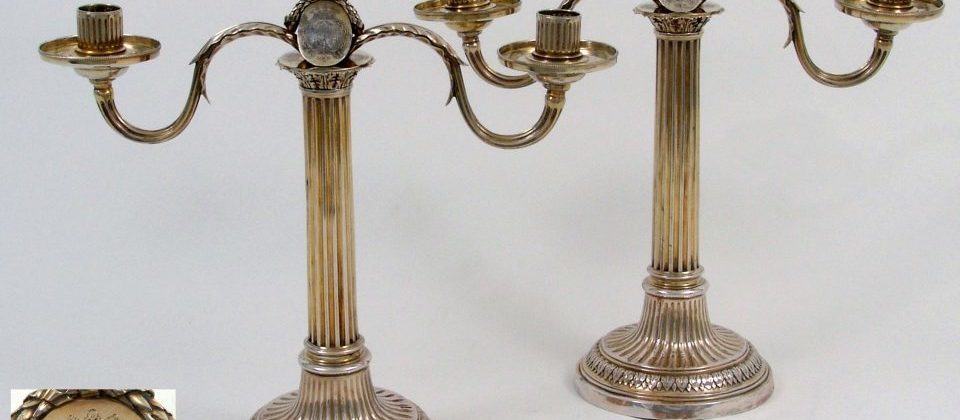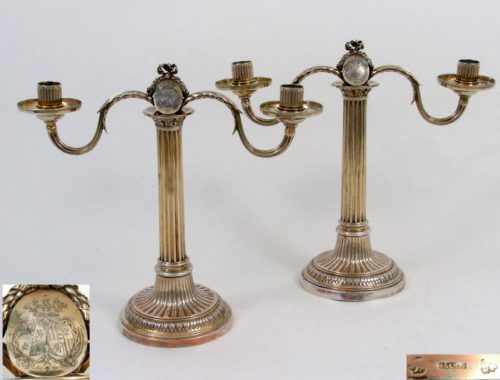Detailed Information
Fine Pair of French Silver Gilt Two Light Neo-Classical Candelabra
This pair of two light candelabra originates from Strasburg, an important city, famous in 18th century also for its vermeil-objects. The candelabra present an elegant example of neoclassicism from the second half of 18th century. The straight shaft rises up on a bright, round foot with a slightly profiled rim. The foot is with a running lamb’s tongue frieze decorated. The shaft has a décor of flutes and is similar to a Greek column, on the top of which is a Corinthian capital. On the capital, there is a cartouche with alliance coats of arms, decorated with a foliage bar. The arms of the candelabrum are stemming from the cartouche, at the end of which is standing a short spout with a candle-tray. The curved arms as well as the spout are also with flutes decorated. The arms are removable. The candelabra retain their original gilding. The maker’s and city marks are punched on both feet and the city’s mark on all four candle-trays. This pair of candelabra presents a very elegant example of Neoclassicism from Strasbourg, a city toward Parisian models oriented, that very well combines strict and light decorative elements.
Vermeil from Strasbourg
The history of silversmith in Strasbourg goes back to the 14th century. As Strasbourg was in 1681 integrated in France from Louis XIV. (1638-1715), the maker’s had their medieval guild organisation since the time of the free and imperial city maintained, until the French Revolution.
The flowering period of the silversmith in Strasbourg was during the 18th century, when the lifestyle was oriented to the “manières françaises”.
Since 1681, the maker’s of Strasbourg had the right to execute pieces of silver in the name of the king. These makers were besides conducting an excellent work and were after the Parisian makers very important. The makers were organised in dynasties. The silver-gilt objects from Strasbourg gained an international prominence. The quality and resistance to oxidation of the silver-gilt silverwares gave the Strasburg-vermeil a first place for the markets of warm and humid lands, specifically those of the remote French colonies, like Senegal.
Besides there were no toll charges at the exported objects and this had as a consequence the acquisition of objects from the German courts also, which had on the meantime adopted French fashion styles.
For an object with similar decorative motifs with flutes and bright foot, which originates from the toilet set of Princess Augusta Wilhelmine of Hesse-Darmstadt, duchess of Palatinate-Zweibrücken, see in the Residenz in Munich (Mü. SK 3931-3932).
Maker
Jacques-Henri Alberti is born in Bärenthal, by Niederbronn in 1730. He realised an apprenticeship by the well-known Jean-Louis Imlin II from 1756 to 1764 and became a master in 1764. He got married to the niece of his master, Catherine-Salomé Emmerich, in 1765. In 1768, Alberti had worked together with Jean Louis Imlin for the execution of the table service of Elisabeth Auguste of the Palatinate-Sulzbach (1721-1794). He had taken over during 1768-1781 the direction of Imlin’s workshop after the death of the later.
Jacques-Henri Alberti was together with Imlin, Kirstein and Oertel among the most important representatives of the vermeil of Strasbourg – i.d. of silver-gilt objects. Many objects from Alberti’s hands are hold at museums of decorative arts in Strasbourg, Colmar, Paris and the Kurpfälzisches Museum in Heidelberg as well as in private collections.
Literature
Haug, H., 1964, Le siècle d’or de l’orfèvrerie de Strasbourg, Ausst. Kat., Paris, 10-31-10.1964
Haug, H., 1978, L’orfèvrerie de Strasbourg dans les collections publiques françaises, Paris: éditions des musées nationaux-palais du Louvre
Martin, É. & Pesneaud-Antheaume, A.-Cl., 2004, Deux siècles d’orfèvrerie à Strasbourg. XVIIIe-XIXe siècles dans les collections du musée des Arts décoratifs, Strasbourg : les musées de Strasbourg



